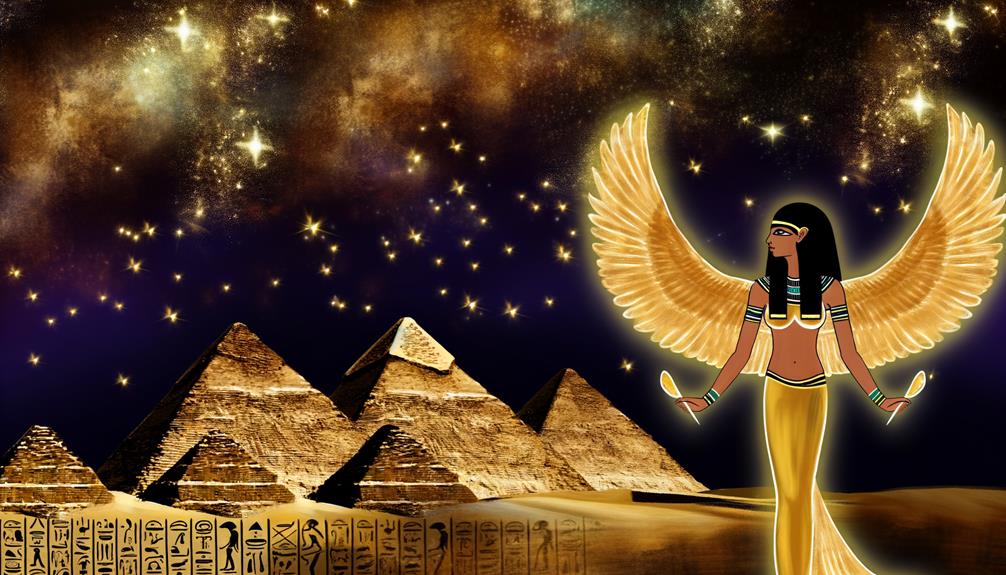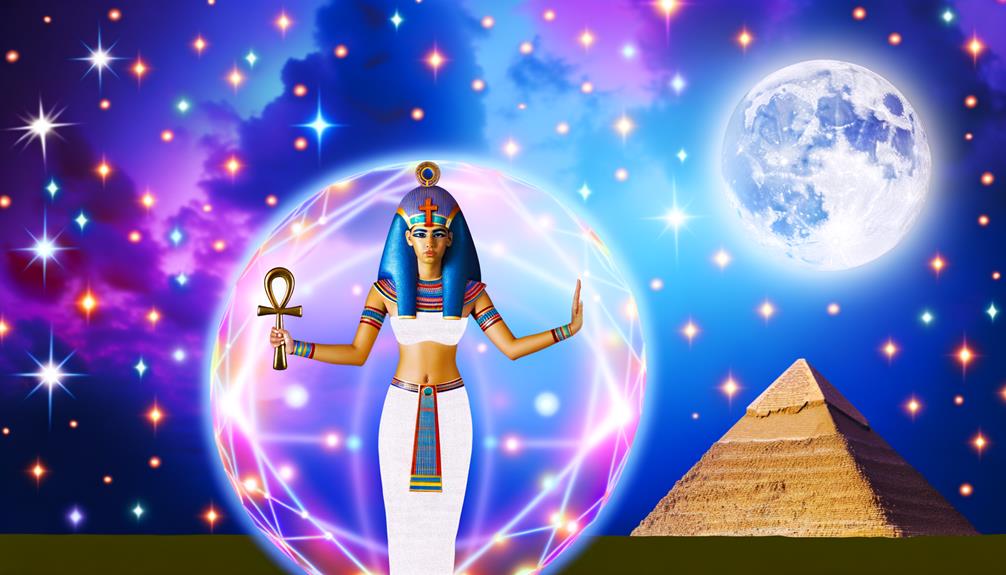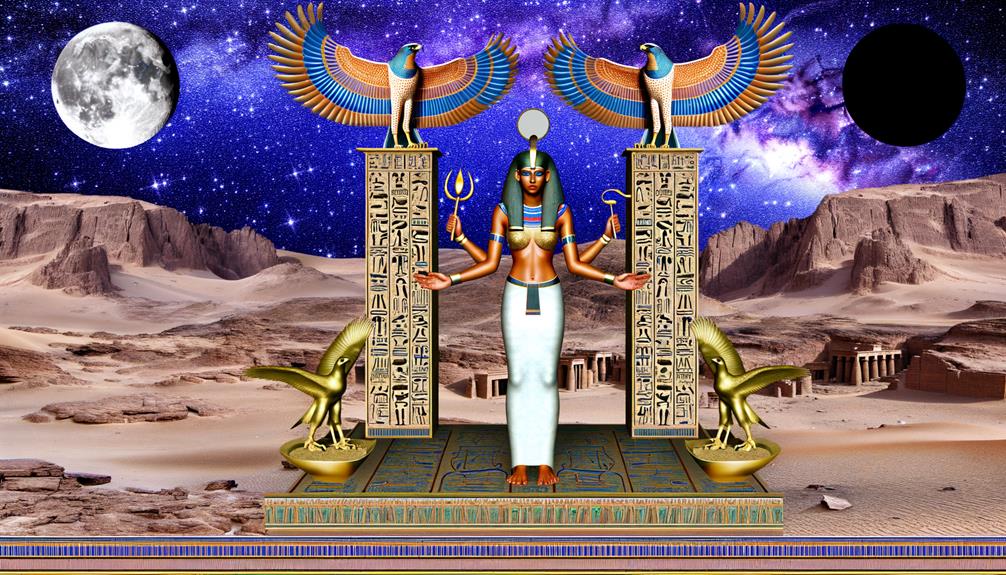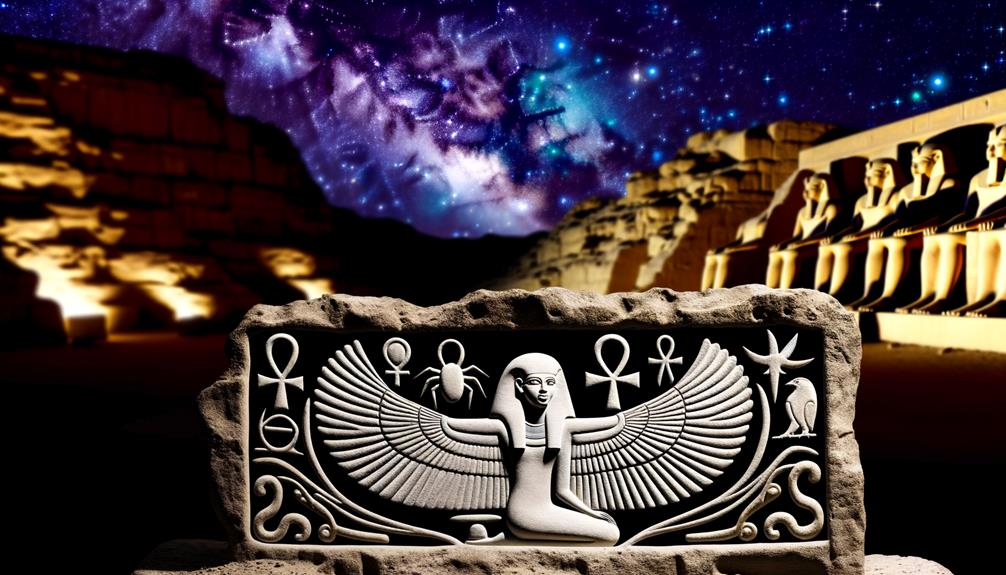You might think that Nephthys, an age-old Egyptian goddess, is just a side character when compared to her well-known sister, Isis. But, let me tell you, it's not the case at all. You see, Nephthys plays a crucial role in Egyptian mythology that's often not given the spotlight it deserves.
She's a protector, a guardian, and her stories are woven into the very fabric of the ancient Egyptian narrative. They're filled with tales of sacrifice, safety, and the intricate ties of family, offering a deep look into the values and spiritual beliefs of the time.
As we make our way through her fascinating stories, we get to meet a goddess who's not just in the backdrop. She stands her ground, earning respect and loyalty.
There's so much more to know about this relatively unknown deity. Digging into her history promises a trip that will test and expand our knowledge of ancient Egyptian mythology. So, let's take this journey together, shall we?
Understanding Nephthys' Role

When you start to unravel the many roles of Nephthys, you can't ignore her deep connection with the temple pylon, the horizon, and her signs as a kite or a woman with falcon wings – all of which signify protection. As a guardian goddess in ancient Egypt, Nephthys wielded tremendous power, symbolizing the journey through death and aiding the pharaoh's voyage to the afterlife. Her duty as the dead's defender is well-documented, and her power was so intense that even demons trembled when she was near.
Recent studies have added some intriguing layers to how we understand Nephthys's role. There have been discussions about her marriage to Set and her son Anubis. However, regardless of her matrimonial connections, Nephthys is associated with Set's kind side and has a respected position in the sacred city of Abydos.
To add to our knowledge, it's worth mentioning Nephthys's relationship with darkness and the dangerous fringes of the desert. Her ability to unearth hidden objects in the moonlight and her status as the Queen of the Embalmers Shop in Memphis underline her protective role. Nephthys's influence wasn't only limited to death, it also reached into areas of mystery and the invisible, making her an intriguing character in the group of ancient Egyptian gods.
Nephthys in Egyptian Mythology

When we delve into Egyptian mythology, we encounter Nephthys, also known as Nebet-hut. She is a symbol of the horizon, often portrayed as a kite or a woman with falcon wings, showcasing her protective qualities. Nephthys, an Egyptian goddess, had a crucial part in the mythological tapestry, mainly in defending the dead.
Here are four interesting elements that highlight Nephthys's role in Egyptian mythology:
- Nephthys was highly respected in the Osiris cult, where she acted as Horus's nursemaid and safeguarded Hapi's canopic jars. As Isis and Osiris's sister, she was a central figure in many myths.
- In addition to being Isis and Osiris's sister, Nephthys was also Set's sister. This relationship highlighted her protective characteristics, linking her to Set's kinder side.
- The New Kingdom period saw the Nephthys cult thrive, particularly under the Ramesside pharaohs.
- Nephthys was uniquely identified as the Bennu bird's protector, indicating her high status in Upper Egyptian Nome VII.
These points help us appreciate the significant part Nephthys played in Egyptian mythology.
Nephthys' Symbolism and Influence

Let's delve into the fascinating world of Nephthys, a prominent figure in Egyptian mythology, and understand the symbolic meaning behind her character, as well as the impact she had on the ancient Egyptian society.
Nephthys is a goddess, part of an important group known as the Heliopolitan Ennead, who had control over the realm of death. She was often referred to as the 'Mistress of the House,' which indicates her connection with the temple pylon, the horizon, and the sacred temple enclosure.
When it comes to visual representations, Nephthys was frequently depicted with vultures or as a woman with falcon wings. These images symbolize protection and the sacred. Nephthys and her sister Isis played interconnected roles, with Nephthys standing for the transition to the afterlife. Her temple was an essential part of the religious scenery, as it was dedicated to her role as a protector.
The reach of Nephthys' symbolism and influence was far and wide, extending to the outskirts of the desert and into the darkness, where she was thought to unveil hidden aspects under the moon's light. The fact that Nephthys was widely revered during the New Kingdom period bears testimony to her enduring relevance in ancient Egyptian society.
Significant Nephthys' Tales

Let's take a journey through the fascinating legends surrounding Nephthys, a goddess who stands as more than just a symbol of protection and transition. She's a key figure in numerous important stories that highlight her influence in the ancient Egyptian world.
- Nephthys and Isis: These sisters share a bond that can't be broken. Nephthys played a vital part in helping Isis resurrect Osiris from the dead, a story that showcases their strong relationship and Nephthys' key role in Osiris' resurrection.
- Mother of Anubis: In some legends, Nephthys is portrayed as the mother of Anubis, the god of death and mummification. This association places her firmly within the domain of death and darkness.
- The Book of the Dead: Nephthys has a vital part in this ancient Egyptian funerary text. She guides spirits through the afterlife, showing her importance in funeral rituals.
- Protector of the Pharaoh: In the story of the Ramesside Pharaohs, Nephthys' protective side is showcased as she safeguards the rulers of Egypt.
These important stories about Nephthys give us a glimpse into her varied role in Egyptian mythology. They allow us to better understand her intriguing character and reveal her crucial contribution to the ancient stories.
Nephthys in Modern Culture

Nephthys, a goddess with ancient origins, still manages to leave a mark on our modern culture. Her association with themes of death, protection, and rebirth keeps us intrigued. Known as the goddess of the air, Nephthys is a symbol of Egypt's ancient heritage. She is a deity encapsulating the spirit of the pharaonic civilization. Her ties to her sister Isis, her link with Set, and her pivotal role in the Egyptian resurrection myth add to her ongoing charm.
You can find references to Nephthys in modern resources about ancient mythology or Egyptology. Her story has been analyzed and reanalyzed numerous times, often in relation to the perpetual conflict between good and evil, as represented in the relationship between Nephthys and Set. Her tale continues to inspire contemporary works of fiction, where she is frequently portrayed as a potent, protective figure.
Symbols linked to Nephthys, like her connection with the number 104, continue to spark modern interpretations. Her reputation as a guardian goddess remains, reminding us of our interest in the mysteries of life, death, and rebirth. Even today, Nephthys' story strikes a chord, showing that her ancient fascination is truly lasting.
Frequently Asked Questions
What Did Nephthys Protect?
Nephthys, the ancient Egyptian goddess, had quite a few important duties under her belt. One of her main roles was to watch over the temple pylon, a critical architectural feature of the time. She also represented the horizon, a key symbol in Egyptian culture. But that's not all – Nephthys played a crucial part in the pharaoh's journey to the afterlife, acting as a guiding force. Plus, she had a special role in protecting the canopic jars of Hapi. So, Nephthys was definitely not a deity to be taken lightly!
What Is the Famous Story About Nephthys?
You know, there's a well-known tale involving Nephthys that really stands out. It revolves around her part in bringing Osiris back to life. The legend goes that after Set had dismembered Osiris, Nephthys stepped in to assist Isis in putting him back together. This episode truly highlights the protective side of Nephthys, and her strength within the ancient Egyptian mythological realm.
Who Was the Egyptian Protective Goddess of the Dead?
Nephthys, the Egyptian goddess, has a fascinating role as the guardian of the deceased. Her emblem, representing the death experience, has been a guiding light for pharaohs during their transition into the afterlife. Known as the 'Queen of the Embalmers Shop,' she holds a respected position in Memphis. This is a testament to her significance in Egyptian culture and her pivotal role in the journey of the soul after death.
Who Was the Egyptian Goddess of Magic Protection?
Did you know that Isis, not Nephthys, is the Egyptian goddess known for magic protection? She's often shown with wings, a symbol of her protective nature. Isis is famous for her magical abilities, particularly when it comes to spells for healing and protection. Isn't that fascinating?

